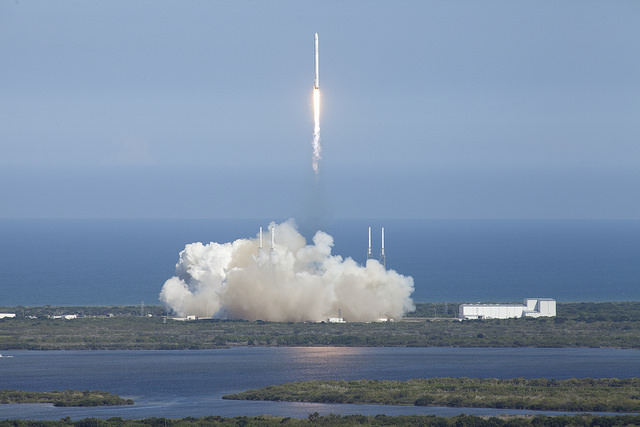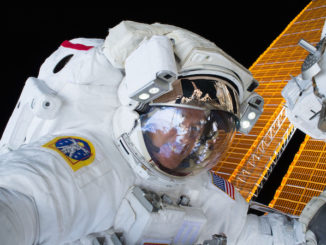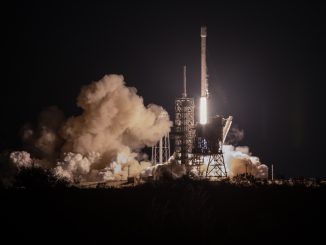
SpaceX’s Falcon 9 rocket successfully launched from Cape Canaveral with a 2.2-ton package of supplies and experiments for the International Space Station on Tuesday, but the booster toppled over after descending to a barge parked in the Atlantic Ocean.
The rocket achieved its primary goal, setting course for a three-day chase of the space station by SpaceX’s Dragon commercial cargo carrier after a smooth liftoff from Cape Canaveral’s Complex 40 launch pad at 4:10:41 p.m. EDT (2010:41 GMT).
But the rocket’s landing attempt — a widely-watched experimental objective — ran into problems just as it contacted SpaceX’s football field-sized barge positioned about 200 miles northeast of Cape Canaveral.
The Falcon 9’s lower section, or first stage, detached from the rocket’s second stage less than three minutes after lifting off from Florida. Rocket boosters normally fall back to the ground uncontrolled and are only used once.
SpaceX is testing a new paradigm in rocketry, with ambitions to recover, refurbish and refly rocket boosters to allow more launches at less cost.
SpaceX tried a barge landing once before, but the rocket ran out of hydraulic fluid to steer aerodynamic fins designed to keep the first stage correctly pointed during descent. The booster came down on the landing platform at an angle, struck the corner of the barge and disintegrated in a fireball.
Tuesday’s landing attempt appeared to have a better result, but the rocket did not survive, according to a series of tweets by Elon Musk, SpaceX’s founder and chief executive.
“Looks like Falcon landed fine, but excess lateral velocity caused it to tip over post landing,” Musk tweeted.
A brief video clip released by SpaceX after the landing showed the rocket’s four landing legs extended, but the booster appears to oscillate before contacting the barge. SpaceX’s video does not show what happened next, ending before the rocket falls over on the platform.
SpaceX employees on a control ship near the remotely-operated barge planned to approach the landing platform later Tuesday to retrieve wreckage before sailing to the ship’s home port in Jacksonville, Florida.
The rough landing occurred less than 10 minutes after launching from Florida’s Space Coast and reaching a maximum altitude of about 125 kilometers — 77 miles — on an arcing trajectory northeast of Cape Canaveral.
Before the kerosene-fueled launcher could blast off, engineers filled the 208-foot-tall Falcon 9 rocket with propellants and high-pressure gases, tested the launcher’s guidance and communications systems, and turned over control of the countdown to a computer-run automated sequencer for the final few minutes before liftoff.
Nine Merlin 1D engines spun up to more than a million pounds of thrust, passed a health check, and powered the fuel-laden launcher off its Cape Canaveral launch pad at 4:10:41 p.m. EDT (2010:41 GMT).
The liftoff was supposed to happen Monday, but storm clouds came too close to the launch pad.
Perched atop a brilliant column of orange exhaust, the rocket pitched northeast from its seaside launch pad, running roughly parallel to the U.S. East Coast as it picked up speed. The gumdrop-shaped Dragon space capsule separated from the Falcon 9’s second stage about 10 minutes later, and a rocket-mounted camera provided clear views of the spaceship unfurling its two power-generating solar arrays to a span of 54 feet.
The Dragon spaceship is making its sixth operational resupply run to the International Space Station under a contract between SpaceX and NASA. The deal initially covered 12 flights and was valued at $1.6 billion, but NASA recently ordered three additional cargo missions for launches in 2017.
NASA and SpaceX have not disclosed the updated value of the contract with the three new missions.
The capsule will match its orbit with the space station’s path around Earth over the next two-and-a-half days, heading for a laser-guided final rendezvous with the complex Friday.
Astronaut Samantha Cristoforetti will take control of the space station’s Canadian-built robotic arm to grapple the SpaceX supply ship around 7 a.m. EDT (1100 GMT) Friday. The robot arm will transfer the Dragon capsule to a berthing port on the station’s Harmony module a few hours later.
An animal habitat with 20 mice, 600,000 tomato speeds, plant and worm specimens, spare parts for the space station’s air revitalization system, and an Italian espresso machine are among the items packed inside the Dragon spacecraft.
The mission is taking up 4,387 pounds of cargo to the space station.
The cargo manifest’s breakdown includes 1,860 pounds of science experiments, 1,142 pounds of gear to maintain space station hardware, 1,102 pounds of food, clothing and provisions for the lab’s six-person crew, 51 pounds of spacewalking equipment, and 35 pounds of computers and cameras.
NASA says the cargo load will support 40 scientific investigations.
The returnable logistics freighter is scheduled to depart the space station May 21 and head for Earth with 3,020 pounds of cargo inside, primarily research specimens such as refrigerated blood, urine and tissue samples from the mice launched inside the Dragon spaceship.

The Dragon cargo craft arrived in orbit Tuesday around the same time the Falcon 9 rocket’s first stage completed its scorching propulsive descent back to Earth from the edge of space.
The flyback maneuvers are purely experimental, SpaceX says, but they are instrumental in the company’s goal of reducing the cost of space transportation and further opening the final frontier for business and exploration.
SpaceX eventually eyes human missions to Mars.
Flying to such lofty destinations affordably will require reusable rockets and spacecraft, according to Musk.
The Falcon 9’s first stage pulsed cold gas thrusters to flip around 180 degrees after the initial boost into space, then lit a subset of its nine Merlin engines for three firings, aiming for SpaceX’s barge — or autonomous spaceport drone ship — in the Atlantic Ocean.
The post-launch engine burns slowed the rocket’s velocity as it re-entered the atmosphere traveling several times faster than the speed of sound, keeping temperatures on the booster’s skin from getting too hot.
The rocket’s four control winglets popped open during the descent to stabilize the launcher.
A single Merlin engine ignited for the final landing burn to steer the rocket over the platform, which was named “Just Read the Instructions” after planet-sized starships featured in science fiction author Iain M. Banks’ Culture novels, according to a report in Tor.com.
Officials said telemetry from the rocket indicated the engine firings during descent occurred as planned.
SpaceX plans to transition its landings to shore, perhaps as soon as a planned launch in July from Vandenberg Air Force Base in California, assuming the company receives approvals from Air Force and civilian safety authorities.
Hans Koenigsmann, SpaceX’s chief engineer and vice president for mission assurance, told reporters after Tuesday’s launch that rocket programmers could tweak the Falcon 9’s descent settings after analyzing what happened with the barge landing.
“I’m pretty sure that we will figure this out and make it work on the barge,” Koenigsmann said. “It’s just a matter of finding the right parameters, finding the right method to do this. I don’t think it’s something fundamental. At the end of the day, you want to land on land anyway, so this makes it a little easier to test.”
Musk joked: “If this works, I’m treating myself to a volcano lair. It’s time.”
Follow Stephen Clark on Twitter: @StephenClark1.



